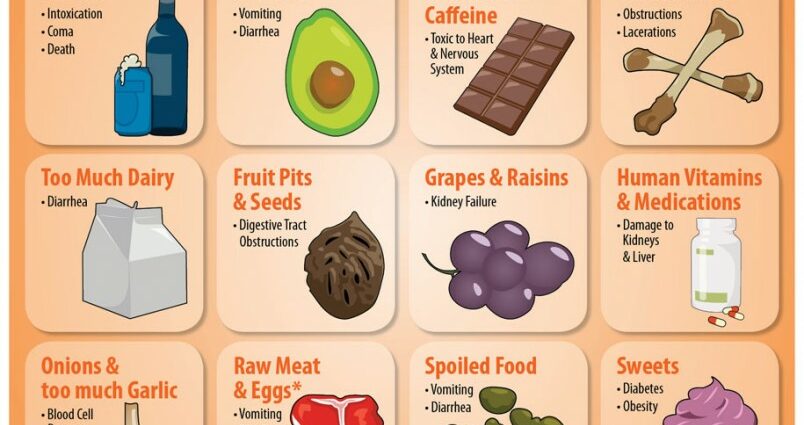Contents
What Foods Are Poisonous For Dogs?
Some foods are toxic to dogs. This is important to know because these are, for the most part, very common foods and completely harmless to humans. This shows the need to avoid anthropomorphism: what is true for you is not necessarily true for your dog. Here are the main foods to be wary of.
Are chocolate and coffee dangerous for your dog?
It is now well known that chocolate is toxic to dogs. Cocoa contains two substances belonging to the methylxanthine family which are toxic to our four-legged friends: theobromine and caffeine.
As with any poison, the signs observed depend on the dose ingested. Chocolates for cooking or dark chocolate are richer in cocoa and therefore more dangerous than milk chocolate. As for white chocolate, the cocoa content is often considered too low to present a real danger.
Signs appear within hours of ingestion. If the dog has ingested a small dose of chocolate, relative to its weight, digestive disturbances can be expected, i.e. vomiting or diarrhea. These can also be linked to the high fat content of chocolate, which can lead to acute pancreatitis. The greater the amount of chocolate eaten, the more serious the consequences can be. There is sometimes marked agitation, an excessively rapid heart rate (tachycardia) or even cardiac arrhythmias. In the worst case, poisoning can lead to seizures and death of the animal.
Thus, if you notice that your dog has ingested chocolate, it is imperative to consult a veterinarian urgently, as soon as possible. If the delay is short enough, the vet will be able to make your dog vomit and thus prevent the chocolate from being digested and the toxins absorbed. Hospitalization may sometimes be necessary, especially if symptoms are already present.
Coffee also contains toxic methylxanthines. However, it is rare for a dog to ingest a large amount of coffee, so poisoning is not frequent.
Allium spp. : onion, garlic, leek, etc., toxic foods?
Plants in the Allium family are toxic to dogs. These bulb plants contain substances that destroy red blood cells. Indeed, during poisoning with onions or garlic, for example, the red blood cells undergo oxidative stress: they are weakened and then destroyed within the blood vessels.
The signs observed usually occur 1 to 5 days after consuming the plant, raw or cooked. The symptoms are mainly related to the ensuing anemia, which is the lack of red blood cells. We then observe a dog:
- tired and weak;
- short of breath;
- sometimes with pale gums;
- digestive disorders can also occur (loss of appetite, vomiting, diarrhea).
In some cases, jaundice can also occur, as well as colored urine (red, black or orange). Toxic effects can appear from 15 to 30g of onion consumed per kilo of body weight (i.e. 150g of onion for a 10 kg dog, for example). Certain breeds seem to be more sensitive to this type of poison, such as the Shiba Inu or the Akita Inu, for example.
Are Grapes and Raisins Poisonous to Your Dog?
Fresh grapes, like raisins, are poisonous in dogs. The toxicity of this fruit is still poorly understood and the substance causing the disorders observed remains unidentified. However, it seems that the toxicity of raisins is greater than that of fresh grapes. The effects of this fruit are unpredictable. There is no relationship between the dose ingested and the severity of symptoms. The disorders in question appear within 24 hours and correspond to digestive disorders then to acute renal failure or even a state of shock. The prognosis is very reserved and the ingestion of grapes should motivate hospitalization with an infusion.
Are Macadamia Nuts Bad for Your Dog?
Macadamia nuts are poisonous in dogs, although again, the mechanism remains poorly understood. Signs appear within 12 hours of ingestion. The dog may present:
- digestive disorders;
- fever ;
- a weakness ;
- tremors;
- loss of balance;
- and difficulty in getting around.
The prognosis is however quite good and the signs should improve within 24 to 48 hours. It is still advisable to make your dog vomit if you have noticed the consumption of macadamia nuts.
Are Xylitol and “Sugar Free” Products Contraindicated for Your Dog?
Xylitol is a very common sweetener in human food, especially in chewing gum and sugar-free candies, or in certain oral hygiene products. It is a substance that causes very serious poisoning in dogs. Even at very low doses, symptoms can be observed.
Xylitol stimulates the release of insulin which lowers the amount of sugar in the blood. Very severe hypoglycaemia can therefore develop as early as 30 minutes after ingestion and up to 12 hours after. The corresponding signs are a feeling of tiredness or weakness, a comatose or lethargic state and, in the worst case, convulsions and death. If these signs are observed, the dog should be given glucose by giving him honey for example (or by rubbing honey on his gums) and then take him to the vet as quickly as possible. As a second step, the dog can develop liver failure. This usually requires hospitalization over several days and is manifested by:
- digestive disorders;
- coagulation disorders with hematomas;
- bleeding;
- etc.










